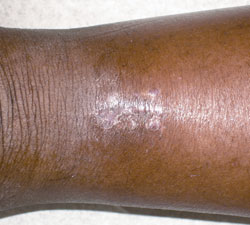Promising results seen with minimally invasive repair of Achilles tendon ruptures
Surgeon cautions that device may not benefit tendon rupture cases with frayed ends.
DENVER — With minimally invasive surgical repair of Achilles tendon ruptures, surgeons look to obtain the advantages of open repair techniques while avoiding the problems of wound complications and infections.
At the American Orthopaedic Foot and Ankle Society’s 24th Annual Meeting, Eric M. Bluman, MD, PhD, discussed the results of minimally invasive repair techniques and highlighted the outcomes of repairs using a minimally invasive Achilles tendon suture device (Achillon, Integra).
“I think that minimally invasive repairs have shown promising results in case series and limited level I studies,” Bluman said. “Obviously, more level I studies are needed, and I think that we need to show caution in using [the Achillon] technique. It may be particularly difficult to use in ruptures in which the tendon ends are frayed or in very distal ruptures where tendon material in which to put your sutures in is limited.”
Tendon suture device
Although his presentation focused on minimally invasive repairs, Bluman use nonoperative treatment for Achilles tendon ruptures when indicated and open repair on occasion. Regarding surgical methods, “I began questioning how I could justify the assault on the posterior tissues in the ankle, when there are methods to obtain repairs with much less invasive methods,” he said.
The minimally invasive repair technique he uses is aided by the Achillon device. The technique uses a 2-cm vertical incision that allows for direct visualization of tendon apposition. It also maintains all the sutures deep to the peritenon, Bluman said. “One of the nice things about the vertical incisions is it is easily converted into an open approach if needed.”
|
Image: Bluman EM |
Bluman said he has used the technique on many patients, 11 of whom have a minimum 1-year follow-up. “All are back to their pre-rupture activity level,” he said. “These are active duty military people and active retirees. All patients are satisfied and would have the procedure again.”
Comparing the uninjured side to the contralateral limb using dynamometry showed no significant difference, he said. He noted no wound problems, infections, re-ruptures, sural nerve injuries or adhesions were seen.
No infections, nerve injuries
A study by the device’s inventor reported on 83 patients whose tendons were repaired using the Achillon device showed no infections and no sural nerve injuries, Bluman said. “They did have three re-ruptures which they attributed to noncompliance of the patients, and all of their patients did eventually return to previous function.”
He also cited an independent study performed by Calder, and colleagues which corroborated the results with the device in 25 patients. The investigators found no infections, wound dehiscence, sural nerve injuries or re-ruptures and reported good functional results.
Although totally percutaneous techniques reduce infection and wound dehiscence rates to 0%, “There have been reports of increased rates of sural nerve injury as high as 17% in some cases,” Bluman said. “There is an inability to directly visualize tendon apposition as well.” Sural nerve injuries have been shown to be due to lassoing of the nerve with the suture in percutaneous cases.
In a study comparing percutaneous and open repair, Lim and colleagues found two adhesions, two re-ruptures and a 21% infection rate in the open repair group. In the percutaneous cohort, they had one re-rupture, one sural neuropathy and had three cases of wound puckering. “This study was limited in that no dynamometry was done and only subjective outcome measures were used for evaluation,” Bluman said.
For more information:Reference:
- Eric M. Bluman, MD, PhD, can be reached at Madigan Army Medical Center, Orthopaedic Surgery, 9040 A. Fitzsimmons Fr., Tacoma, WA 98431; 253-968-1581; e-mail: emb43@cornell.edu. He receives miscellaneous non-income support from DePuy.
- Bluman EM. Minimally invasive surgical repair of the Achilles tendon rupture. Presented at the American Orthopaedic Foot and Ankle Society 24th Annual Summer Meeting. June 26-28, 2008. Denver.

